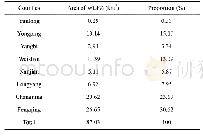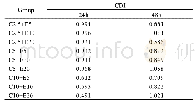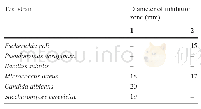《Table 2 Interdiffusion coefficients of the interaction zone (IZ) of water-quenched U-10wt%Zr/Zr-4 d
 提示:宽带有限、当前游客访问压缩模式
提示:宽带有限、当前游客访问压缩模式
本系列图表出处文件名:随高清版一同展现
《U-10Zr/Zr-4合金界面的微观结构及生长动力学研究(英文)》
To analyze the growth kinetics of the diffusional interaction between the U-10wt%Zr fuel and Zr-4 cladding,the thickness of the IZ was measured from the terminal ends of the U-10wt%Zr and Zr-4 alloys,where the concentration gradient becomes negligible.Table 2 reports the average thickness of the IZ as a function of the annealing temperature.The numerical data on the thickness of the IZ were measured at 12 randomly selected locations on the EDS line scan for each sample.The interdiffusion coefficient of the U-10wt%Zr/Zr-4 IZ was calculated for annealing at 580,600,650,700,750,800,900,950,1000,and 1100°C,as listed in Table 2 and presented in Fig.6.The principal alloying elements in Zr-4 are Sn,Fe,and Cr,as shown in Table 1.The maximum solubility of Sn inα-Zr is about 9.3 wt%,whereas the solubility of Fe inα-Zr is very low(120?g/g at 820°C[34]).Almost all of the Fe would be precipitated as the Zr(Fe,Cr)2 type with a Fe/Cr ratio close to 1.5[35],and the solubility of Cr inα-Zr is very low.Further,Sn generally remains in solid solution in the hexagonal Zr phase.According to the U-Sn phase diagram,however,when uranium encounters tin,they react to form intermetallics.In addition,considering that the Sn concentration in the Zr-4 alloy is only~1 at%,the multicomponent alloy system of U-10wt%Zr and Zr-4 was simplified to the U-Zr binary system.Assuming that the growth of the IZ was controlled by diffusion and followed a parabolic growth law[30],the correlation between the thickness and annealing time is expressed as
| 图表编号 | XD0011263000 严禁用于非法目的 |
|---|---|
| 绘制时间 | 2018.09.01 |
| 作者 | 张羽廷、王鑫、刘朋闯、曾钢、庞晓轩、贾建平、盛六四、张鹏程 |
| 绘制单位 | 表面物理与化学重点实验室、中国科学技术大学核科学技术学院、表面物理与化学重点实验室、表面物理与化学重点实验室、中国工程物理研究院材料研究所、中国工程物理研究院材料研究所、中国工程物理研究院材料研究所、中国科学技术大学核科学技术学院、表面物理与化学重点实验室 |
| 更多格式 | 高清、无水印(增值服务) |
查看“Table 2 Interdiffusion coefficients of the interaction zone (IZ) of water-quenched U-10wt%Zr/Zr-4 diffusion couples from”的人还看了
-

- Table 2 Distribution of the water-level-fluctuating zone (WLFZ) along the the Xiaowan Reservoir in different administra-





